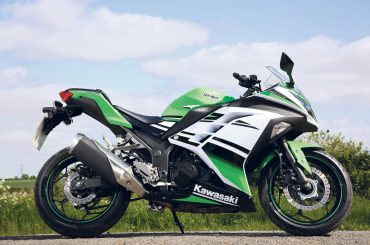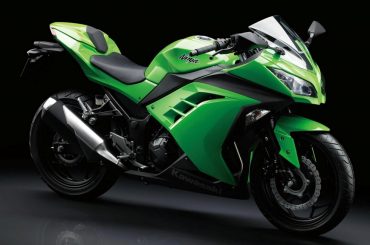Kawasaki Ninja 300 – also known as EX300 – is a sports bike with 296 cc displacement. It is sold in Asia, Australia, Europe, and North America. Manufacturing of Ninja 300 started back in 2012 and is still in production with various upgrades in many countries. It is available in four exciting colors including white, green, blue, and black.
The Ninja 300 is based on the Ninja 250R, a lightweight and inexpensive sports bike in production for over three decades. Like the Ninja 250R, it has a full fairing, but a wider rear tire; 140/70, instead of the 130/70 on the 250R. By comparison with the 250R, the Ninja 300 also has a slightly smaller fuel tank, taller gearing, and a back-torque-limiting slipper clutch with an assist mechanism that decreases clutch lever effort. It was successful in replacing Ninja 250R in some markets and in some both were sold separately. It was able to outperform Ninja 250R in many markets mainly because of its high-performance, 296 ccs air-cooled engine.
Despite being a sportbike, Kawasaki Ninja 300 has comfortable ergonomics such as a windscreen effectively protecting from windblast which promotes commuting. However, like all other bikes, Ninja 300 does come with some cons. We’ll talk about one of them – its ground clearance problems in this article. So if you’re also facing this issue, stay tuned with us and keep reading ahead.

Effects of Ground Clearance
Before delving deeper into the specific aspects of Ninja 300, let us first explore what ground clearance is and what are its effects on motorbikes.
Ground clearance is the amount of space between the lowest part of a vehicle’s frame and the ground. People often want to increase the ground clearance of their bikes because an increased ground clearance on a bike usually increases the lean angle that can be achieved before scraping parts on the road surface. A leaner angle allows a tighter turning radius. There are, of course, limits. You can lean so far that there is not enough tire surface making contact with the road to maintain traction and the bike leans right to the ground. Sportbikes come from the factory closer to this limit and with many, there is a little additional lean angle to be gained by raising the bike. But generally, most of the bikes have a useful amount of lean angle that can be gained by raising them.
Ninja 300 Ground Clearance Problems
One of the problems that bikers face with Kawasaki Ninja 300 is its 140 mm ground clearance which seems a little less to some people because it often causes hurdles crossing speed bumps. Some people even have to change the tires of their bikes to increase ground clearance. Not only is this process costly but it’s also very tiring and time-consuming.
These problems amplify further in case of bad road conditions especially if you’re taking your bike for a long route or on mountainous and sloppy paths. It’s even worse when more people are riding the bike.
However, you should also keep in mind the weight of your bike. If your bike isn’t heavy, a lower ground clearance works much better. Similarly, it also depends on the conditions of the roads you are travelling on. If the roads don’t have a lot of speed breakers, you are good to go with the lower ground clearance. However, for bumpy roads, you would need to raise the height of your bike a little. Moreover, it also depends on your height. For tall people, it is generally advisable to increase the ground clearance because they are usually more comfortable that way. But it depends on your personal choices as well.
Possible Solutions
If you do feel that your Kawasaki Ninja 300 has the low ground clearance and you are facing difficulty travelling on a bumpy road, we have a word of advice for you!
You can easily increase the ground clearance of your bike by replacing the rear suspension link to raise the bike. But please bear in mind that doing this raises the seat height and changes the front fork angle as well. In some cases, it might even affect the drivability of the bike by making it slightly unstable at higher speeds and reducing the turning radius of the bike.
Checkout our article on the Ninja 300 Turbo kit
We hope that you enjoyed reading the article and found it insightful. We have highlighted above the instances where it is advisable to increase the ground clearance on your Kawasaki Ninja 300 or keep it as it is. The final choice, of course, comes down to a lot of factors such as the weight of your bike, the condition of the roads, the usability of the bike, and so on. We advise you to keep in mind all these factors before making the final decision.





